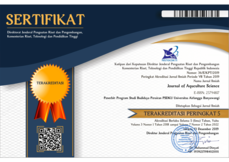The influence of the addition of red pepper (Capsicum annuum L.) and red amaranth (Alternanthera amoena Voss) on the feed for color acumen of the guppies fish (Poecilia reticulata)
Downloads
Guppy fish is currently in high demand because they has interesting color variations such as red, blue, yellow. The carotenoid content in red peppers and red spinach is able to increase the brightness of the color of the fish. This research aims to find out the effect of the addition of red peppers and red spinach on guppy fish color. Completely Randomized Design with 3 treatment and 3 repetitions was used. The research data was analyzed by using the Adope Photoshop app by observing the discoloration that occurred before and after the treatment by using color libraries. The study found that the percentage of blue and purple in guppy fish increased. This was related to the absence of carotene that associated with protein and produces carotenoproteins. The most prominent discoloration result was the treatment 1 (addition of peppers). In treatment 1 there was a significant discoloration of the blue color with the code 732-0 from 0% to 11.9%, while in the treatment 2 (addition of spinach) color coded 732-0 was changed from 0% to 5.88%, the treatment 3(control) treatment was changed from 1.21 % to 0.6%. Meanwhile, the purple color with the code 728-0 on treatment 1 from 0% to 2.36%, on treatment 2 from 0% to 0.22% and on treatment 3 purple color did not came out. It can be concluded that the most influential to the color of guppy fish was peppers, spinach and control treatment, respectively.
Keywords : red spinach, carotene, guppy fish, red peppers, color.
Aysun, K., Durmaz, Y., Hekimoglu. 2010. Effect of Natural Pigment Sourche on Colouration of Cichlid (Cichlasomaseverum Sp. Heckel, 1840). Journal of Animal and Veterinary Advances , 9(3), 566-569.
Effendie, Moch. Ichsan., 1997. Biologi Perikanan. Yayasan Pustaka Nusantara, Yogyakarta.
Fakultas Teknobiologi, Universitas Atma Jaya Jogjakarta.2017. Pengaruh Pakan Berbeda pada Induk Terhadap Jumlah Larva Ikan Guppy (Poecilia reticulata). Jurnal Biota, 2 (2), 77í¢Ë†'81.
Hasyim, Z., Ambeng, Andriana, I., Saputri, A.R. 2018. Potensi Pemberian Pakan Cacing Tanah Lumbricus Rubellus Terhadap Warna pada Ikan Guppy Poecilea reticulata. Jurnal Ilmu Alam dan Lingkungan. 9(17), 14-21.
Lesmana, D.S. 2002. Agar Warna Ikan Hias Cemerlang. Jakarta : Penebar Swadaya.
Malik, T., Syaifuddin, M., Amin, M. 2019. Maskulinisasi Ikan Guppy (Poecilia reticulata) Melalui Penggunaan Air Kelapa (Cocos nucifera) dengan Konsentrasi Berbeda. Jurnal Akuakultur Rawa Indonesia, 7(1), 13 - 24
Nurcahyo, Wisnu. 2018. Parasit pada Ikan. Gadjah Mada University Press, Yogyakarta.
Putriana, N., Wahju, T., Alamsjah, M.A. 2015. Pengaruh Penambahan Perasan Paprika Merah (Capsicum annuum) dalam Pakan Terhadap Tingkat Kecerahan Warna Ikan Koi (Cyprinus carpio L.). Jurnal Ilmiah Perikanan dan Kelautan, 7(2), 189-194.
Rohmawaty O. 2010. Analisis Kelayakan Pengembangan Usaha Ikan Hias Air Tawar pada Arifin Fish Farm, Desa Ciluar, Kecamatan Bogor Utara, Kota Bogor. Institut Pertanian Bogor; Bogor. 107 Halaman.
Septiyan, R., Rusliadi dan Putra. 2017. The Effect of Different Feeding on rowth and Color of Guppy Fish (Poecilia reticulata). Jurnal Online Mahasiswa Fakultas Perikanan dan Ilmu Kelautan Universitas Riau.
Serlahwaty, D., Yunahara,F., dan Asriyana. 2009. Penetapan Kadar -Karoten dalam Buah Paprika Merah, Kuning, dan Hijau (Capsicum annuum var. annuum L.) secara Kromatografi Cair Kinerja Tinggi. Seminar Nasional PATPI (Perhimpunan Ahli Teknologi Pangan Indonesia)
Sholichin, Haetami K, Suherman H. 2012. Pengaruh Penambahan Tepung Rebon pada pakan Buatan terhadap nilai Chroma Ikan maskoki (Charassius auratus). Perikanan dan Kelautan, 3(4) : 185-190.
Sukmara. 2007. Sex Reversal pada Ikan Gapi (Poecilia reticulate Peters) Secara Perendaman Larva dalam Larutan Madu 5ml/l. Departemen Budidaya Perairan. Fakultas Perikanan dan Ilmu Kelautan, IPB. Bogor.
Vevers, G. 1982. The Colours o6f Animals. Etword Arnold (publisher), London.



















